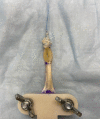Biomechanical Comparison of a Novel Multiplanar, Perpendicular Whipstitch With the Krackow Stitch and Standard Commercial Whipstitch
- PMID: 35982831
- PMCID: PMC9380225
- DOI: 10.1177/23259671221107034
Biomechanical Comparison of a Novel Multiplanar, Perpendicular Whipstitch With the Krackow Stitch and Standard Commercial Whipstitch
Abstract
Background: Using alternating orthogonal suture throws with the looped whipstitch technique may allow enhanced suture fixation.
Hypothesis: It was hypothesized that this novel multiplanar, perpendicular looped whipstitch (MP) technique would have improved biomechanical properties compared with the standard looped whipstitch (WS) and Krackow stitch (KS).
Study design: Controlled laboratory study.
Methods: A total of 30 cadaveric tibialis anterior tendons were randomly assigned into 3 groups of 10. Tendons were secured to a custom clamp, and the other end was sutured using 1 of 3 techniques: the KS, WS, or novel MP. The MP was performed with alternating orthogonal throws starting right to left, then front to back, left to right, and back to front. Each technique used 4 passes of No. 2 FiberWire spaced 5 mm apart and ending 10 mm from the tendon end. Tendons were preloaded to 5 N, pretensioned to 50 N at 100 mm/min for 3 cycles, returned to 5 N for 1 minute, cycled from 5 to 100 N at 200 mm/min for 100 cycles, and then loaded to failure at 20 mm/min. Elongation was recorded after pretensioning and cycling and was measured both across the suture-tendon interface and from the base of the suture-tendon interface to markings on the suture limbs (construct elongation). One-way analyses of variance were performed, with Bonferroni post hoc analysis when appropriate.
Results: There were no differences in cross-sectional area or stiffness among the 3 techniques. The ultimate load for WS (183.33 ± 57.44 N) was less compared with both MP (270.76 ± 39.36 N) and KS (298.90 ± 25.94 N) (P ≤ .001 for both). There was less construct elongation for KS compared with WS and MP for total displacement, measured from pretensioning to the end of cycling (P < .001). All 3 techniques saw a decrease in length (shortening) at the suture-tendon interface during testing. There was more shortening at the suture-tendon interface for WS compared with KS (P = .006).
Conclusion: The KS appears superior, as it maximized strength while minimizing construct elongation or graft shortening. The ultimate load of the MP technique was greater than that of the standard technique but not significantly different from that of the KS technique.
Clinical relevance: The KS is preferred. If using a WS, multiplanar, perpendicular passes should be considered.
Keywords: Krackow; biomechanics; fatigue testing; tendon; ultimate failure load; whipstitch.
© The Author(s) 2022.
Conflict of interest statement
One or more of the authors has declared the following potential conflict of interest or source of funding: The cadaveric tendons used in this study were donated by RTI Surgical, and the suture material (FiberWire and FiberLoop) was donated by Arthrex. The University of Michigan Research Advisory Committee provided grant funding for supplies. dsdf S.M. has received education payments from Pinnacle. D.P.P. has received education payments from Arthrex. M.T.F. has received education payments from Evolution Surgical, consulting fees from Stryker, speaking fees from Smith & Nephew, and hospitality payments from Wright Medical. AOSSM checks author disclosures against the Open Payments Database (OPD). AOSSM has not conducted an independent investigation on the OPD and disclaims any liability or responsibility relating thereto.
Figures







References
-
- Barber FA, Howard MS, Piccirillo J, Spenciner DB. A biomechanical comparison of six suture configurations for soft tissue-based graft traction and fixation. Arthroscopy. 2019;35(4):1163–1169. doi:10.1016/j.arthro.2018.10.140 - PubMed
-
- Choi GW, Kim HJ, Lee TH, Park SH, Lee HS. Clinical comparison of the two-stranded single and four-stranded double Krackow techniques for acute Achilles tendon ruptures. Knee Surg Sports Traumatol Arthrosc. 2017;25(6):1878–1883. doi:10.1007/s00167-016-4265-0 - PubMed
-
- Deramo DM, White KL, Parks BG, Hinton RY. Krackow locking stitch versus nonlocking premanufactured loop stitch for soft-tissue fixation: a biomechanical study. Arthroscopy. 2008;24(5):599–603. doi:10.1016/j.arthro.2007.11.020 - PubMed
-
- Fennell CW, Ballard JM, Pflaster DS, Adkins RH. Comparative evaluation of bone suture anchor to bone tunnel fixation of tibialis anterior tendon in cadaveric cuboid bone: a biomechanical investigation. Foot ankle Int. 1995;16(10):641–645. doi:10.1177/107110079501601011 - PubMed
-
- Frank RM, Bernardoni ED, Veera SS, et al. Biomechanical analysis of all-suture suture anchor fixation compared with conventional suture anchors and interference screws for biceps tenodesis. Arthroscopy. 2019;35(6):1760–1768. doi:10.1016/j.arthro.2019.01.026 - PubMed
LinkOut - more resources
Full Text Sources

